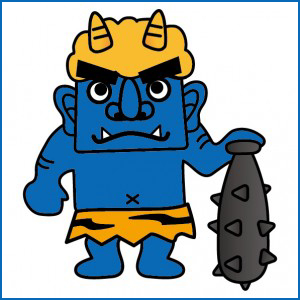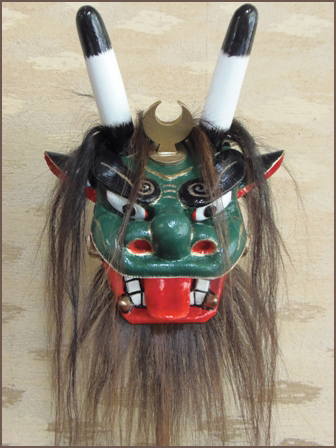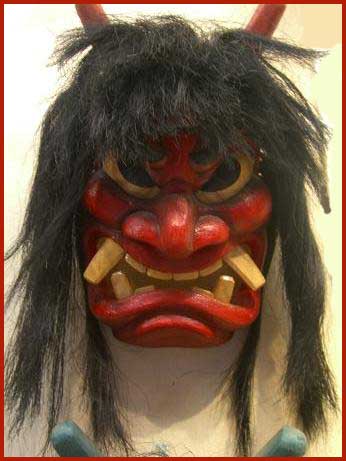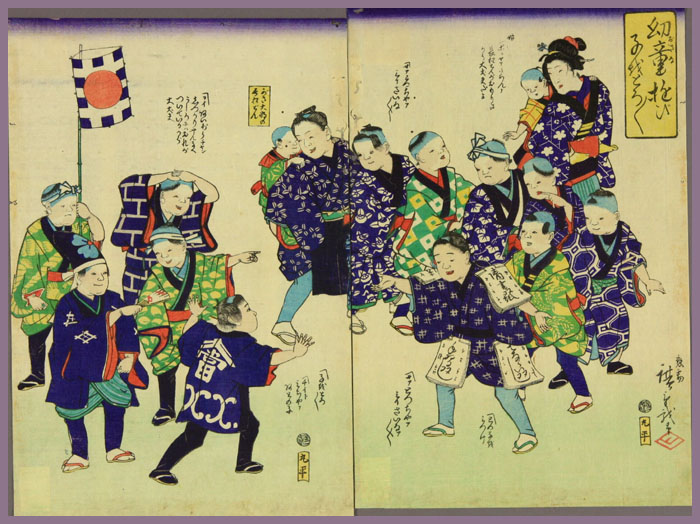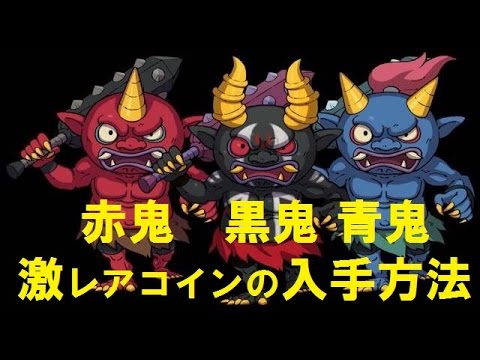. Onipedia - 鬼ペディア - Oni Demons - ABC-List - .
:::::::::::::::::::::::::::::::::::::::::::::::::::::::::::::::::::::::::::::::::::::::::::::::::::::::::::::::::::::::::::::::::::::::::::::::::::::::::::::::::::::::::::::::::::
oni matsuri 鬼祭り Oni Demon Festivals

There are many festivals involving the local ONI of Japan.
- oni gyooretsu 鬼行列 Oni gyoretsu, Demon Parade
- - - - - . Shuten Doji Festival 酒呑童子行列 and Demon Parade .
. yatai to oni 屋台と鬼 Oni decorations on festival floats .
..............................................................................................................................................
setsubun 節分 seasonal divide - driving out the local Oni
. Onibashiri 鬼走 running demons for Setsubun .
- and Oni eshiki 鬼会式 Demon Festival and Ritual
. Namahage なまはげ Demons from Akita .
. Onigo Matsuri 鬼子祭り "Demon Boys Festival" .
..... Kokuseki-Ji Naked Man Festival 黒石裸祭 Kuroishi Festival
. oniyo 鬼夜 "demon's night" fire festival .
..... Daizenji Town, Kurume, Fukuoka
- - - - - to be updated !
:::::::::::::::::::::::::::::::::::::::::::::::::::::::::::::::::::::::::::::::::::::::::::::::::::::::::::::::::::::::::::::::::::::::::::::::::::::::::::::::::::::::::::::::::::
kiraigoo 鬼来迎 ki raigo - Demons coming down to Earth
and oni mai 鬼舞 Demon Dance

source : yokoshibahikari.jp/kiraigou/kiraigo
Temple 広済寺 Kosai-Ji
千葉県山武郡横芝光町虫生 / Musho, Yokoshibahikari, Sanbu District, Chiba
Ritual on August 16
. raigō, raigoo 来迎 "welcoming approach" .
Amida Buddha coming down to welcome a new soul
:::::::::::::::::::::::::::::::::::::::::::::::::::::::::::::::::::::::::::::::::::::::::::::::::::::::::::::::::::::::::::::::::::::::::::::::::::::::::::::::::::::::::::::::::::
Oniyama sakura matsuri 鬼山桜まつり Sakura Festival at Oniyama Demon Mountain
Misaki town 美咲町打穴中地区 Okayama
. Momotaro Legend in Misaki Town 三咲町の桃太郎伝説 .
:::::::::::::::::::::::::::::::::::::::::::::::::::::::::::::::::::::::::::::::::::::::::::::::::::::::::::::::::::::::::::::::::::::::::::::::::::::::::::::::::::::::::::::::::::
- quote -
The Japanese Festival Where Demons Beat Up Kids with Sticks

- CLICK for more photos !
In a small town in Hiroshima called 小屋浦 Koyaura, the third weekend of every October is the autumn festival. A festival the children of the town dread.
..... Terrifying demons known as マッカ(赤鬼)‘Makka’ (all red) chase the children of the town and when he catches them they get a savage hit with a stick.
Sometimes the demon will also attempt to kidnap the child.
The only thing that can abate the demon is if the child promises to be good from now on. Parents even willingly give their child up to be beaten and kidnapped.
This tradition, native to Koyaura is over 100 years old. ...
- source : grapee.jp/en... -
:::::::::::::::::::::::::::::::::::::::::::::::::::::::::::::::::::::::::::::::::::::::::::::::::::::::::::::::::::::::::::::::::::::::::::::::::::::::::::::::::::::::::::::::::::
. Japanese Legends - 伝説 民話 昔話 – ABC-List .
............................................................................ Aichi 愛知県
In Aichi (Mikawa 三河) there are many oni matsuri オニマツリ, all held on the 15th day of the New Year.
At the shrine Boo jinja 某神社 Bo Jinja in 豊橋市東八丁 Toyohashi
At 三河幡豆郡某村 Mikawa Hazugun in various villages
In Nagoya the さねさこ祭 Sanesako Matsuri.
This timing is related to the Sagicho fire rituals.
. sagichoo 左義長 Sagicho Rituals .
.......................................................................
名古屋市 Nagoya 熱田区 Atsuta
. 大薬師の鬼祭 "Festival of the Demons of Yakushi Nyorai" .
高蔵不動院 Takakura Fudo-In
.......................................................................
豊橋 Toyohashi
Toyohashi Oni Matsuri 豊橋鬼祭
豊橋市の安久美神戸神明社 Akumi-Kambe Shinmeisha - on February 10 and 11
豊橋神明社

masks of Tengu (L), Kuro-oni (C) and Aka-oni (R)
- quote -
The Demon Festival has been carried on since around 940 in the Heian period (794-1192)
and was designated a National Important Intangible Folk Cultural Property in 1980.
On the festival eve (Feb.10), it's started with Iwato-no-mai dance.
The heros and heroines of this day are boys and girls.
The main event of this festival is called "Aka-oni to Tengu no Karakai /rivalry between Aka-oni (Red Demon) and Tengu (long-nosed goblin)".
(literal meaning of karakai is raillery, but it's totally rivalry)
The story performed by the red demon and Tengu has come from Japanese mythology.
A destructive god ( Susanoo-no-mikoto = red demon) appeared in Takamagahara (lit. "high heavenly plain", where gods live) and destroyed the granaries.
A god of martial arts (Sarutahiko-no-mikoto = Tengu) fought to chasten and straighten him out.
Then all the gods felt happy and danced kagura.
People innovated dengaku performances, which soaked up this story, to a Shinto ritual festival, and to pray for a rich harvest and prosperity.
Aka-oni walks zigzag (Zigzag walking symbolizes lightning. Lightning is caused by Oni on a cloud by the Japanese folk tales)
***
During the climax of this festival,
Red Demon repeatedly provokes battle with Tengu, but is defeated.
He escapes from the shrine yard and runs around the town
Kuro-oni (Black Devil = Ame-no-koyame-no-mikoto of the mythology) fills the role of judge.
It is said that if you are showered with this powder or eat tankiri-ame, you will not get ill during the summer.
Lots of visitors are excited to get tankiri-ame and a powder shower.
- Details of the festival and photos :
- source : kikuko-nagoya.com/html/onimatsuri-toyohashi-

- More masks from the Oni Festival and Aichi
- reference source : tees.ne.jp/~itsukit/Gallery2... -
. Tengu from Aichi .
赤鬼と天狗のからかい Aka-Oni and Tengu having a bout
- - - - - Link with many photos :
- reference source : toyohashionimatsuri.web... -
.......................................................................
岡崎市 Okazaki
滝山寺鬼祭 Takisan-Ji Oni Matsuri
愛知県岡崎市滝町山籠107 / Yamagomori-107 Takichō, Okazaki-shi, Aichi

Three Oni masks of 婆面 Grandmother, 爺面 Grandfather and 孫面 Grandchild Demon

............................................................................ Ehime 愛媛県
北宇和郡 Kitauwa district 吉田町 Yoshida
. Uwajima Ushi-oni matsuri 宇和島牛鬼祭り Uwajima Ushi-oni festival .
............................................................................ Miyazaki 宮崎県
. Onioi matsuri, oni-oi matsuri 鬼追い祭り .
at Kumano shrine 熊野神社, Soo town 曽於市, Miyazaki
............................................................................ Saga 佐賀県
藤津郡 Fujitsu district 太良町 Tara
竹崎観世音寺修正会鬼祭 At the temple Takezaki Kanzeon-Ji
佐賀県藤津郡太良町大字大浦甲竹崎248
Te 修正会 Shusho-E ritual in the night of the fifth day of the New Year.
Demons who live on the sea off Takezaki and the demon masks which are kept prisoner in a box (onibako 鬼箱) in the Kannon Hall try to get out on the fifth day of the New Year and call out to each other to overthrow the island. To prevent this, the villagers have to shout even louder to protect their island - the orabigoe おらび声 heavenly voice.
The villagers are only clad in a fundoshi ふんどし loincloth, so this is a famous hadaka matsuri 裸祭 naked vestival.
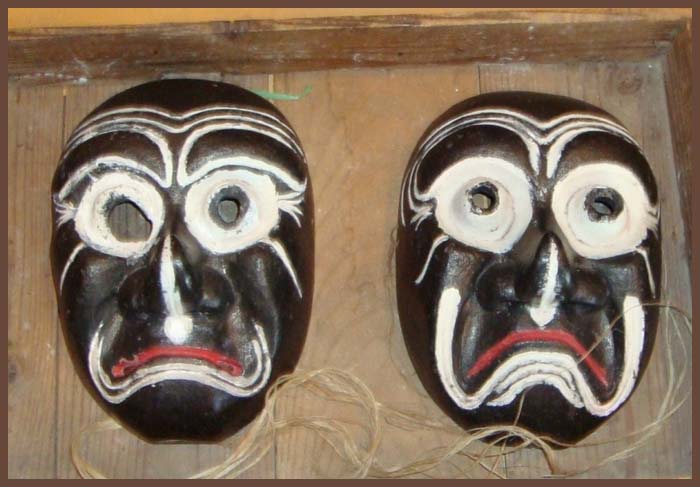
If someone opens this Onibako, hes eyes will get sick soon or he will get a high fever. So nobody ever dared to open this box.
diashooboo, osaki ダイショウボウ,オサキ
竹崎観音堂で毎年陰暦の1月5日の夜から6日にかけてお粉荒れる鬼祭りで用いられるダイショウボウ(樫の生木の棒)は、夜道に杖として使うと俗耳には聞えないダイショウ、ダイショウ、という叫びによってオサキなどの妖魔を退散させる。この棒を取ったものは一年中降伏にみまわれる。
。竹崎地区の未婚の未婚の若者男子は「鬼之忌屋」という若者宿に入り、既婚男子は宿老宿に入る。若者組からは4名の鬼副(オンゼイ)が選ばれる。追儺の行法の鬼追い、童子舞などに特色がある。
..............................................................................................................................................
- reference : nichibun yokai database 妖怪データベース -
- books -
柳星甫 : 鬼祭
伊藤一郎 : 佐賀県大浦村竹崎観音堂の鬼祭
:::::::::::::::::::::::::::::::::::::::::::::::::::::::::::::::::::::::::::::::::::::::::::::::::::::::::::::::::::::::::::::::::::::::::::::::::::::::::::::::::::::::::::::::::::
. - - - Join the Onipedia friends on facebook ! - - - .
:::::::::::::::::::::::::::::::::::::::::::::::::::::::::::::::::::::::::::::::::::::::::::::::::::::::::::::::::::::::::::::::::::::::::::::::::::::::::::::::::::::::::::::::::::
. Onipedia - 鬼ペディア - Oni Demons - ABC-List - .
. Tengu 天狗と伝説 Tengu legends "Long-nosed Goblin" .
. - yookai, yōkai 妖怪 Yokai monsters - .
. Legends and Tales from Japan 伝説 - Introduction .
. Mingei 民芸 Regional Folk Art from Japan .
:::::::::::::::::::::::::::::::::::::::::::::::::::::::::::::::::::::::::::::::::::::::::::::::::::::::::::::::::::::::::::::::::::::::::::::::::::::::::::::::::::::::::::::::::::
[ . BACK to DARUMA MUSEUM TOP . ]
[ . BACK to WORLDKIGO . TOP . ]
- #onimatsuri #onifestival #kiraigo -
:::::::::::::::::::::::::::::::::::::::::::::::::::::::::::::::::::::::::::::::::::::::::::::::::::::::::::::::::::::::::::::::::::::::::::::::::::::::::::::::::::::::::::::::::::
